
Just south of San Diego and the U.S./Mexico border, is the peninsula known as Baja California, affectionately known as Baja. Its 1800+ miles of coastline continuously beckon surfers to come experience its renowned breaks.
We created this guide to give adventurous surfers the most important information needed to create an epic road trip.
We give you a massive amount of well-vetted advice so that you have a solid understanding of where to surf in Mexico and what to expect while you’re there.
*It is worth mentioning here that there are a ton more great surfing spots all along the coast—too many to count and many without names. Our advice specifically caters to the popular spots that work well on a road trip. We encourage exploring and would love to hear about your off-the-beaten path discoveries. Follow our marked spots, to find the hidden gems. The true gems would never be spilled online. Not by me anyway.
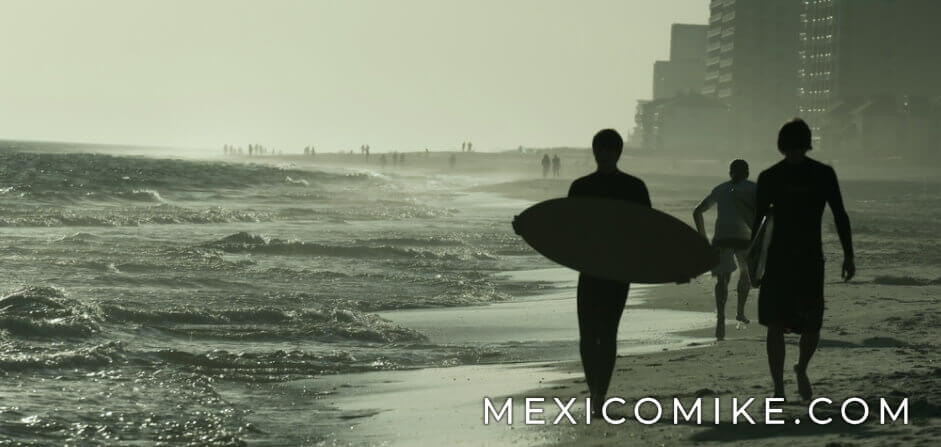
Before we give you all our intel on Baja’s Best Surf Spots, we need to share what we feel is the #1 SECRET to any memorable trip over the border. It’s at the core of how we do business and it’s what we have noticed that can make or break a surf trip to Baja.
The secret sauce to a successful surf trip can be summed up in one word—RESPECT. If you surf, you know what we are talking about already.
We advise that you up your game even more when you cross the border:
We know we really don’t have to tell you how a little respect goes a long way when it comes to having an epic adventure because you feel it with every wave that you catch.
* Get Mexican car insurance before you go. It’s required by law. All policies automatically come with roadside assistance. It’s cheap and the cost of insurance will be covered by your first tow or flat repair. Don’t go without it!
The Baja California Peninsula is made of two Mexican states – Baja California (Yep – It’s named the same as the peninsula and we think that’s confusing too) & Baja California Sur. The names we use:
Playas de Tijuana is the first surfing spot that you’ll come to after crossing the United States border and heading down into Mexico.
Many surfers tend to skip by Tijuana and hustle to the well-known reef breaks farther south. However, a quick stop at the Playas de Tijuana can be a great way to kick off a Baja surf trip. It has some of the best surf in Northern Baja. The waves are a good size; the waters aren’t too busy, and there’s a view. The Playas de Tijuana will amp you up for more.
Be sure to check the weather report in Tijuana before heading down for the day. The waves never really falter depending on the weather conditions, but after a big rain, there can be a lot of pollutants gathered in the water. However, Playas de Tijuana is working on fixing the pollution. The beaches (and the surfing) are improving thanks to some federal efforts to clean it up.
Photo Ops. The border fence literally runs down the northern part of the beach and into the water and you can see San Diego from the beach.
How to Get There. To access the beach just follow the highly visible signs on your way to the coastal toll road (M-1 Cuota).
The Waves. The surf at Playas de Tijuana suits anyone from beginners to pros. It’s a good place to learn to surf and a great place to spend the day if you already know what you’re doing out on the water. Playas de Tijuana has a beach break. The waves are going to be a little bit smaller than those at some of the beaches with reef breaks farther south in Baja. The waves come inconsistently, are about head-high (five feet), and are surprisingly fast and powerful. The flip side of this is that if you get knocked down, you don’t have to worry much – the bottom is entirely sand.
Localism. The beach at Playas de Tijuana is such a great Baja surf spot because it never gets very crowded. You likely find a handful of locals and a sprinkling of tourists but compared to other top-notch beaches it’s remarkably empty. The relative emptiness of the waters gives you first pick at the waves.
Local Vibe. While you’ll need to make lodging reservations on your own, it should be noted that Tijuana is one of the most dangerous places in Baja Mexico at night. If you are planning on staying for a night in the city, then make sure that it is at a well-secured hostel, motel, or resort – don’t try camping in the area
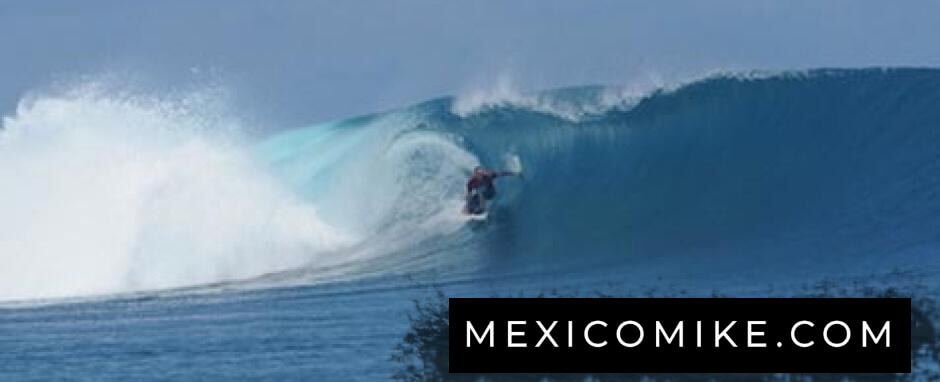
The next region that you will come to if you continue heading south along the west coast of the Baja Peninsula is the Rosarito area. There are several top-quality surfing spots in this area.
The most popular spot in the Rosarito region, Baja Malibu, is 16 miles south of San Diego. Baja Malibu, as its name implies, is reminiscent of Malibu, California. It has the same sandy beaches, small-town vibe, and spitting swells. It’s quite a bit more northern than some of Baja Mexico’s other premiere surfing spots.
When it’s a big day at Baja Malibu, the place fills up very fast. It’s one of the most well-loved surfing spots in all of Baja Mexico and surfers from all around Southern California head down to check it out. Despite the crowds, it is still possible to have a great time here. There’s plenty of room for everyone making it a spot that you don’t want to miss.
It’s important to note that the water around this spot is a little bit colder than the water at other beaches in North Baja. Even in the warmest of summer months, you’ll want to pack a wetsuit just to be safe.
How to Get There. Getting here is easy – take the “Baja Malibu” exit from the toll road. There’s a dead-end street right next to a bar called “Tecate Jacks” where you can usually park at for free. There’s also parking on the dead-end street to the north side of the houses (Baja Malibu Residential Complex).
The Waves. They roll in smooth and glassy from the Pacific. This beach break has tubular action. The waves here are out of this world. They are actually some of the thickest on the Pacific. They get big, about head high to double overhead (five to ten feet) and are known to come in as top to bottom barrels. Best of all is that the waves are consistent. Waves are best here near low tide. Winter is one of the best times to surf this spot—the crowds have thinned out a little by then and the waves are bigger and more frequent.
Rosarito Beach is another well-known surfing spot in the Rosarito area. It is worth adding to your Baja Road trip itinerary. Rosarito Beach offers multiple miles of surf breaks to pick and choose from. The surf is good but not nearly as good as Baja Malibu to the north and not anywhere near as good as the surf farther to the south. However, it’s worth a stop, especially if you feel like socializing for a bit.
The Local Vibe. Rosarito Beach is famous for its friendly atmosphere and numerous restaurants, bars, and clubs. Once upon a time, Rosarito was a popular party hub. Around 2007, the area went through a rough patch and had its share of hard times. Now, Rosarito Beach is slowly making a comeback.
The Waves. Rosarito Beach offers some excellent surfing for beginners to expert surfers. Regulars say the best waves tend to be south of Rosarito’s pier.
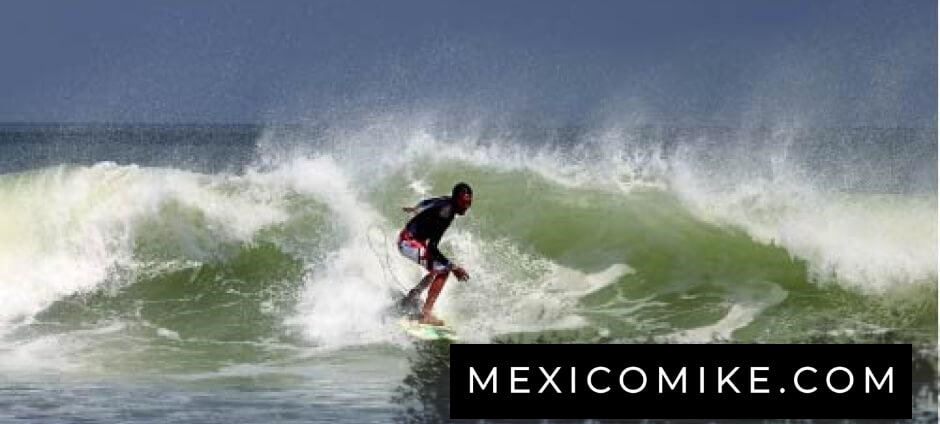
The next stop to consider surfing is the Calafia area which is just six miles south of Rosarito Beach. The surfing is unique, and there is also a small hotel, Hotel Calafia Rosarito, for surfers who want to make a real vacation of their surf trip. It’s an older 3-star hotel that is extremely affordable. There is a restaurant on site, but you can find some tasty steak houses nearby as well
How to Get There. It’s in easy driving distance of the U.S. border on hwy 1 (not the toll road).
The Waves. There are lots of rocks so cover your feet unless you’ve got the hippie skin.
Mushrooms is a terrific Baja surfing spot. It has a secret feel to it. Mushrooms is one of the most overlooked and least crowded in the area. Thousands of surfers drive right by it every season and few ever stop to catch a few waves.
Localism. If you ever get the opportunity to surf Mushrooms, then there is a good chance that you will be one of the only surfers in the water.
How to Get There. Most little-known spots in Baja take a bit of trekking to reach, but not Mushrooms. You simply take the last Rosarito exit (Pemex Station) on the toll road and turn left. The beach is about four miles down the free road. It is easy to spot because of the funky white tower (formerly pink) leaning haphazardly to one side. It’s been in a state of disrepair for over two decades, so most people don’t pay much attention to it. Mushrooms is just in front of the tower. There are plenty of places to park for free.
The Waves. The break at Mushrooms regularly produces good-sized waves. It’s the consistency that sets this spot apart from other little-known Baja surfing spots. The waves are not necessarily bigger than what you would find in San Diego; they commonly reach between head high (five feet) and double overhead high (ten feet).
Note of caution: Mushrooms is slightly more dangerous than other reef breaks in the Baja area. It has a bottom made out of a sand and rock mix. The rocks are very sharp and can leave a nasty gash if you fall on one. The undercurrent is also strong. It is recommended that you wear booties at Mushrooms and that beginners stay out of the water – intermediates and experts should be fine. There is no lifeguard present.
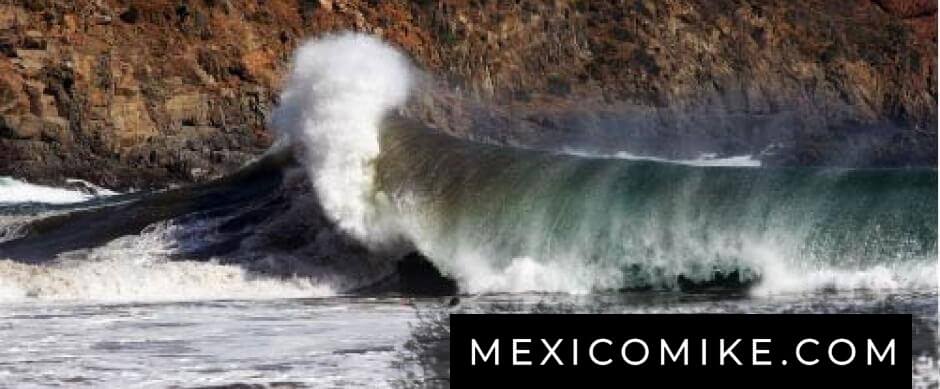
Drive south a little farther along the road in Baja and you will come to a spot named K-38 after the kilometer marker on its turnoff from the highway.
How to Get There. K-38 is one of the most accessible surfing spots in Baja. It is located about 15 minutes south of Rosarito Beach on the free road (the highway runs parallel to the free road), and a few minutes south of Calafia. The “K-38” road marker is not the best “sign,” but a large statue of Jesus and the Las Rocas Hotel is also immediately next to the turnoff. Watch for them.
The Waves. K-38 is a surf spot that is for beginners to experts. It consists of four beach breaks that each offer a different type of wave. This surf spot is about 400 yards long in total. There are several distinct “mini-spots” on the short stretch of the beach.
The most popular is locally known as The Point and is located on the far-left side (looking out towards the ocean) of the beach. It’s a right-hand surf break that can kick up some seriously long waves. It’s not uncommon to be able to ride a wave on the point for over 200 yards. On a good day, the waves at the point are around head high (five feet).
The other, smaller sections of K38 are known as The Left, Maria’s, and Theresa’s. The Left is the least popular break at K-38 and that is mostly because it is a pretty lackluster wave compared to the others. It’s a low, slow-wave that can be quite funky because of the reef located immediately below it, but, on a good day, the waves can offer a decent short ride.
Maria’s is more consistent than The Left and more low-key than The Point. It’s a safe place for beginners, young kids, and families to try out surfing. Even one-foot waves are surfable on Maria’s. On big days, there are occasionally waves of about head height which makes things a little more interesting for beginning surfers.
Finally, Theresa’s is located on the far-right side of K-38. It’s a bit funky compared to the other breaks and is generally fast, shifty, and beat. A lot of cutbacks are required on a normal wave. You should only attempt to surf at Theresa’s if you have some experience under your belt. When you’re surfing Theresa’s, make sure that you wear your booties – it is a haven for sea urchins and sharp rocks.
Local Vibe. Check out the nice bar just above Theresa’s break.
After you hit up K-38, the next reasonably well-known surf spot that you will pass is La Fonda. In addition to having terrific waves, La Fonda has a very safe and pleasant campground. It is one of the best midway points to plan an overnight stop at. If you’re into surfing, your Mexico surf trip should include La Fonda in Baja.
Local Vibe. The camping area is located on the top of a bluff. If you’re planning a multiple-day surfing trip you can camp overnight at La Fonda for $7. The crowd at the campground is usually cheery and friendly.
Photo Ops. Steep cliff with ocean views up and down the coast. Catch a sunset from the campground where there are great views of the Pacific.
How to Get There. La Fonda is located at kilometer 58 on the main highway, the Mexico toll road in Baja. To reach it you should take the Alisitos exit and follow Old Highway 1 (Mexico 1-Libre). You’re looking for the “La Fonda Campground”. The day parking lot is also located at the campground. It costs $5 to park at La Fonda. The views from the parking lot alone worth the small fee. The lot is on top of a steep cliff with ocean views up and down the coast. Getting your first glimpse of the waves from the vantage point is inspiration enough for a strong day of surfing.
The Waves. La Fonda tends to be a consistent surf area no matter what the season. While its waves can always be counted upon to deliver excitement, some can grow to immense proportions making it an extraordinary place to surf in northern Baja California. The best waves are about shoulder high (four feet). Occasionally you see head-high (five feet) waves which are powerful. Remember this is a shallow beach break. If you’re a beginner you might want to watch – there are no lifeguards. Other than that, the waves at La Fonda work well for beginners and experts alike.
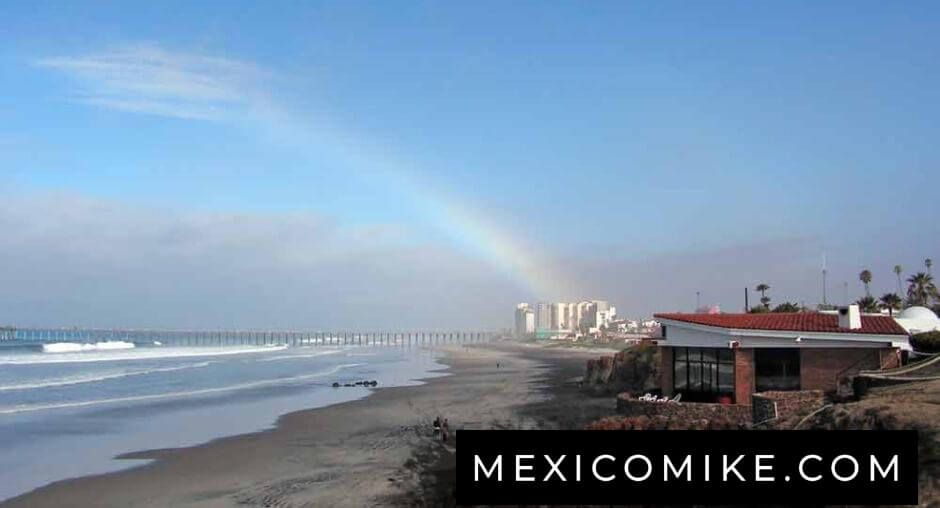
Ensenada enjoys a vibrant surfing culture. With its nearby Killers at Islas de Todos Santos, and dozens of other sweet spots, surfers have been heading to the area since the 1940s. Ensenada is a great home base for surfers who want to check out the action at various beaches. Surf shops are plentiful here and have boards available to rent.
Local Vibe. Ensenada’s beaches attract travelers from all over the world. Aside from surfing, there are also plenty of other water sports to enjoy, like sailing, scuba, and snorkeling in Ensenada. There are plenty of accommodations to suit any budget— everything from luxury hotels and villas to simple hostels that are economical and provide basic amenities. You’ll find several waterfront campgrounds, RV parks, and world-class resorts to indulge in as well.
Photo Ops. Gorgeous scenery, unsurpassed sunrises to the East, sunsets over the Pacific. There’s a lot to take in and capture here. It’s no wonder Ensenada’s beaches are famous throughout the world.
It feels counterintuitive since you’re moving towards the equator, but the waters off the Baja Peninsula get colder as you head south.
Continuing south, located eight miles north of Ensenada, but still only slightly more than sixty miles from the border, San Miguel boasts renowned surfing.
The Waves. Its waves are considered by surfers to be among the peninsula’s best. Its righthand pointbreak is the best in Baja. The San Miguel point break can get crowded during the northwest-west swell.
Local Vibe. The camping here is a bit more expensive but they have hookups and warm showers. Ensenada is just 10 minutes further south for excellent food. We recommend Mahi Mahi.
Continuing on down the road from San Miguel, you’ll come to Ensenada or La Bufadora where you can take a boat to the Islas de Todos Santos – one of the gnarliest surfing spots in all of Baja.
Twelve miles off the coast near Ensenada are two tiny islands, Islas de Todos Santos. There are no facilities on the islands. They are only home to a couple of lighthouses and some of the best waves you’ll find anywhere. (Be careful not to confuse these islands with Todos Santos, a village on the southern tip of the peninsula in Baja California Sur) The Islas de Todos Santos (also known as El Martillo) is one of the premier surfing spots in Baja. Professional surfers consider the waves at Islas de Todos Santos to rival the biggest in Hawaii. The break here, Killers, is appropriately named. Killers often boast of waves with a 40′ face.
Even if your skills aren’t up for the big waves at El Martillo, it is worth taking the ferry out to the island just to witness the action. It really is an unbelievable experience. If you have intermediate to advanced surfing skills and a hefty amount of experience under your belt, then there is hardly a better place to spend a day with your board.
Photo Ops. The Islands of Todos Santos (Islas de Todos Santos) are located on the west side of the Baja Peninsula and offer some of the gnarliest waves in Baja. They get their nickname – El Martillo (in English: The Hammer) – from their unnerving ability to batter the unsuspecting surfer into the water. Lots of opportunities to catch someone charging and you’ll definitely spot a few getting pummeled. If you go at the right time of year, you might even catch a glimpse of a pro.
The Waves. The name says it all – it’s huge here. They are some of the biggest and best in North America. Many professional surfers say that El Martillo is the best Pacific surfing spot sans Hawaii.
Aside from the monster waves…
On a typical day, the waves at El Martillo are overhead high (five feet). They only come in from the right-hand side but are very hard, fast, and hollow. If you head to the beach at the peak of the season (mid-winter), then you can expect waves that are double overhead high (ten feet).
Like most other famous surfing beaches, it is best to arrive at El Martillo as early as possible. The beaches fill up fast with surfers and beachgoers alike once the sun is up high.
Localism. The pros and the ones who have been there before get priority, but if you are good, you are welcomed here. The waters can get crowded, and you’ll have to vie for a wave at the peak of the afternoon. It’s no matter though – once you catch your first big wave at El Martillo, all the waiting will be well worth it.
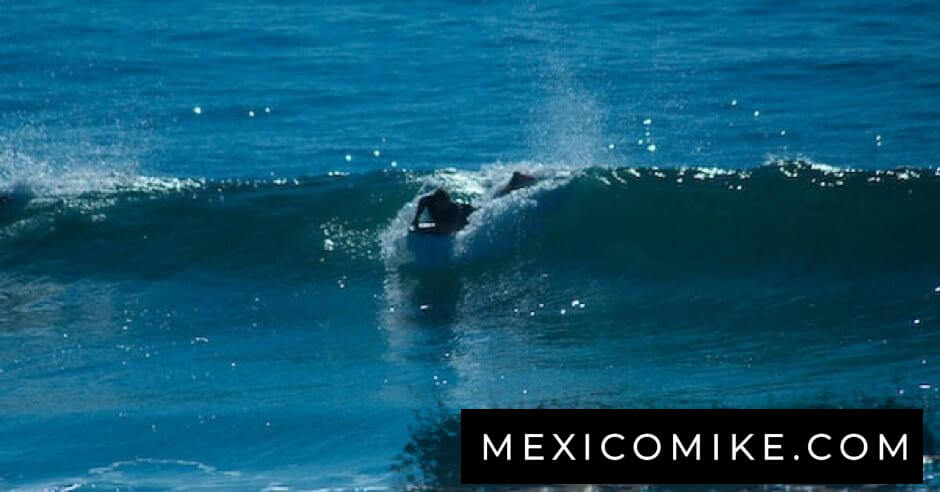
About an hour south of Ensenada, you’ll find Punta San Jose, also known as Lighthouse, which is a dependable surfing spot in North Baja. While it’s not the absolute best surf spot in all of Baja Mexico, it is very consistent and there are almost always waves breaking on any day of the year. It’s a good “safety” spot for your Baja surfing trip.
The beach at Punta San Jose is very popular with the San Diego crowd since it is such a short drive from the border. It is best to avoid the holidays and the weekends and surf here during a slow weekday. Beachgoers tend to gather near the lighthouse, so if you do come upon a crowd, try heading down to one of the far ends of the beach. The waves are a little smaller, but you can ride them for just as long (and without worrying about running into any swimmers).
The Waves. Punta San Jose is an exposed beach and reef break. The waves come in at head high (five feet) or just under almost every day of the year. If you head to Punta San Jose on a big day in the winter, the waves can sometimes reach double overhead high (ten feet). The waves come in from both the right-hand and left-hand sides and are almost always very hard, fast, and powerful. They can sometimes become choppy and beat, but this only serves to further challenge the experienced surfer.
Note of caution: Though Punta San Jose is a very popular place for surfers, it does have its fair share of dangers. These include a strong rip current and sharp rocks. Wear booties! Another worry is sharks. They’re not a common sight around Punta San Jose, but they are seen a few times per year. It’s best to check the local news regarding shark activity before heading down.
How to Get There. You can reach Punta San Jose by taking the dirt road west from the toll highway from Santo Tomas about 50 miles south of Ensenada. It’s a bumpy ride (and you might want to bring a map), but once you see the Pacific, you won’t be disappointed.
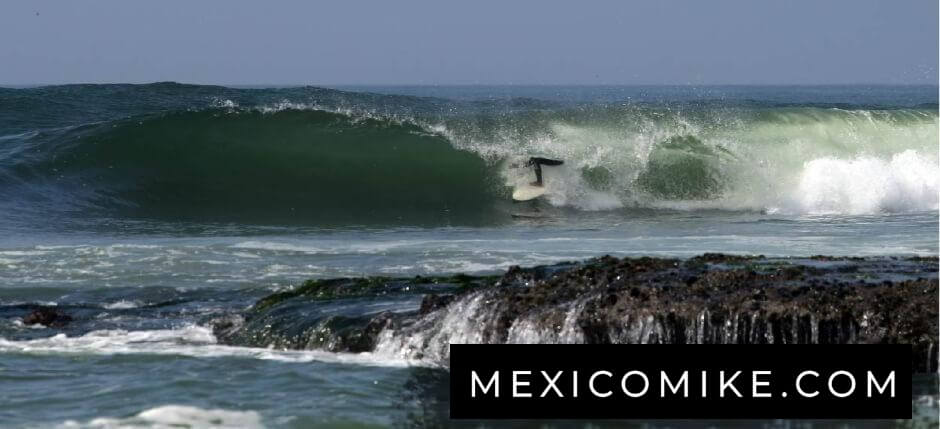
The southern half of the peninsula, Baja California Sur, is a favorite area for surfers because of its variety of surfing spots. Each spot is different and suits a different surfing style and skill level. If you’re lucky enough to travel this far south, check out some of the surf spots below.
Volcanoes is located just north of San Quintin. It is a reasonably well-known surfing spot but not that many people actually stop to check it out. Its waves are treacherous and most people, certainly most beginner and intermediate surfers, opt to visit the mellower beaches in the near vicinity. The beach at Volcanoes has an almost myth-like quality to it.
The Waves. While there are plenty of beaches that work well for beginners, Volcanoes is not one of them. Because of its ferocious and unpredictable waves, it is best used only by surfers of the highest caliber. The waves at Volcanoes are about head high (five feet) to overhead high (ten feet) and come in from the right-hand side off of one of the most unique surf breaks in Baja – a beach break made of volcanic rock from the volcano. They are very fast and powerful, and their shape tends to become rougher and choppier as the day wears on.
Volcanoes is very dangerous. In addition to its unpredictable waves, there is an incredibly strong undercurrent that is amplified by the fact that you have to paddle a long way out to catch a wave. To make matters even sketchier, the bottom is littered with extremely sharp fragments of volcanic rock. If you’re planning on surfing at Volcanoes, wear booties to protect your feet. You should also only go out when you are completely rested since you’ll have to work so hard to stay put against the current’s pull. Bring a friend along. Never surf at Volcanoes alone.
Local Vibe. If you are an experienced surfer and work up the nerve to check Volcanoes out, you’ll find a beach stretching south from the village of to the north end of the village of El Playon. A small but imposing ancient volcano rests at the end nearest El Playon.
How to Get There. If you’re prepared to face the hazards of Volcanoes, then you can get there by exiting Highway 1 near the big military facility near Cabo San Quintin. There is a yellow sign that says, “Entrada y Salida De Vehs Militares” and a white sign that says “Zona Turisticas De Atractivos Naturales Bahia Falsa Parque Volcanico” at the turnoff. Follow the dirt road that leads past these two signs but be prepared. This dirt road is known among locals to be one of the bumpiest in the region. However, once you make it to the beach and see the ocean, the bumpy ride will be well worth it.
How to Get There. If you’re prepared to face the hazards of Volcanoes, then you can get there by exiting Highway 1 near the big military facility near Cabo San Quintin. There is a yellow sign that says, “Entrada y Salida De Vehs Militares” and a white sign that says “Zona Turisticas De Atractivos Naturales Bahia Falsa Parque Volcanico” at the turnoff. Follow the dirt road that leads past these two signs but be prepared. This dirt road is known among locals to be one of the bumpiest in the region. However, once you make it to the beach and see the ocean, the bumpy ride will be well worth it.
Excellent surfing to match the excellent nickname. This region is about four hundred miles down on Mexico Highway 1. The breaks of Seven Sisters are between Punta Cono to Punta Rosarito. The water tends to be colder here than San Diego’s waters, but the perfect waves attract the world’s best surfers.
This Baja California South beach has consistent swells. Typically crowded, this beach and its waves attract surfers of all levels. It is easy to locate on the Baja surf map off Mexico 19.

Located near the southern tip of Baja, Punta Perfecta is a little-known surfing spot that can provide hours of fun on the right day. Even though it is located within a few minute’s drive of many top-quality surfing spots, it is often overlooked because it’s an inconsistent spot. If you’re ever surfing at the other spots in the area (Nine Palms, Boca del Tule, Frailes), then definitely stop by to check Punta Perfecta out. If you’re lucky, the waves will be breaking.
The natural beauty of the area attracts large crowds of beach-goers, but the waves are largely open for surfing. Part of the reason you have so much room is that you’ll have earned your spot—you do have to paddle pretty far out to get to the waves here.
The Waves. The best time of year to find the so-called “right day” to surf here is summer when the south swells are the strongest. At most other times of the year, the waves aren’t strong enough to break before crashing into the beach. On its very best days, Punta Perfecta throws forth waves of startling heights for an area with such dismal “every day” waves. They can reach heights between head high (five feet) and double overhead high (ten feet). They are very powerful and fast, oftentimes tube-shaped. They are very glassy creating an extremely smooth ride.
Photo Ops. The name Punta Perfecta (Point Perfect) likely comes from the beach’s scenic beauty. It is comprised largely of white sand beaches, picturesque rocky outcrops, and cleaner and clearer water than almost anywhere in Mexico. Simply put, it is a very beautiful place.
How to get there. The best way to reach Punta Perfecta is en route Cabo San Lucas. Drive south on the main road from Vinorama until you see the point in the distance. There aren’t many signs marking the turnoff, so, if it is your first visit to the area, you should ask for directions at one of the many surf shops in Cabo. Many of them will give you a marked map with directions to the spot.
There are so many great surf spots in Baja California Sur to write about, but we have saved one of the best for last—Shipwrecks. Despite its slightly creepy name (and even more creepy nickname, Chainsaw Point), Shipwrecks, consistently holds its own when placed side by side with Baja’s other surf offerings. One of the best parts about surfing at this spot in Baja California Sur is the fact that it rarely gets busy. It’s a long drive south from Quatro Casas and not many tourists or locals stop by on a regular basis. It’s a large beach area with a consistent stream of good waves so that you don’t have to fight for a turn on your board.
Local Vibe. If you stay up-to-date with the surf happenings in Mexico, then you might have also heard Shipwrecks referred to as Punta San Jacinto. It goes by a lot of names, but its most commonly used name, Shipwrecks, comes from the abundance of ships that wrecked just off of its coast. A few that sank nearest the beach can still be seen poking out of the water today. The ocean around Punta San Jacinto is treacherous.
The Waves. Though Shipwrecks hasn’t been very kind to mariners, it has long been a favorite spot for Baja surfing. The waves are around head height (five feet) and they come consistently with a full shape that makes carving easy. They rarely get too big for beginners to handle, yet they still remain fun for experts. The biggest danger to keep an eye out for is the exposed shipwrecks – you definitely don’t want to crash into one of them!
Localism. It’s out of the way for most casual surfers, so if you’re lucky (and you’re likely to be), you’ll have the waves all to yourself. Remember, it’s a desolate area; bring along a friend in case of an emergency.
Photo Ops. Shipwrecks is a beautiful Baja surfing spot. It is rare to find such smooth waves without the big crowds. Plus, the beach is nice and the sunken wrecks provide great scenery.
How to Get There. To visit Shipwrecks, catch the road near the El Presidente Hotel in San Jose Del Cabo. It’s a little road without signs. Stop at the hotel for directions if you’re having trouble finding the turnoff. Once you’re on the road, it’s a straight shot to the beach.
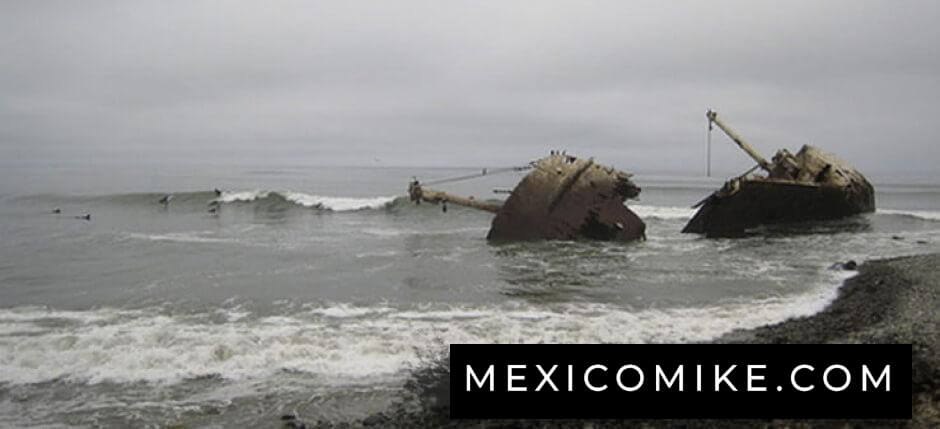
Driver’s license.
Credit card. Credit cards automatically convert dollars to pesos and pesos to dollars. Make sure your bank knows you’re heading down to Mexico so they don’t freeze your card.
Water.
Cash. We recommend bringing a few hundred dollars including several $1’s and $5’s for “propina”.
Medications. If you take prescription drugs bring a copy of the prescription, just in case.
First aid kit. Just a small kit for when you cut your Achilles on a board fin.
Masks. Covid-19 precautions in Baja are similar to those in California.
What is the difference between simply surfing in Mexico and safely surfing in Mexico?… a little common sense and some thinking ahead.
Surfing in Baja – like surfing anywhere else – does hold its fair share of dangers. Surfing is a sport where you place yourself largely at the mercy of the ocean and all of the other dangers that come along with it. Whether you’re a first-time surfer or a seasoned expert, it is essential to keep these safety tips in mind when you’re out on the water.
Know the Spot. The most important thing that you can do to ensure your safety while surfing in Baja Mexico is to know the spot that you’re surfing at. Don’t just go out and surf on any nice waves that you drive by – read up on the spot first or at the very least ask a local about it. The surf spots in Baja are all vastly different and some are quite unpredictable, even dangerous.
Knowing the spot consists primarily of getting a feel for the skill level required to surf the waves. It also includes learning of any individual dangers of the surf spots such as sharp rocks hidden in the sand or strong rip currents. Be sure to also understand the local laws regarding surfing. Many popular beaches in Baja Mexico have regulations involving “no-surf zones.”
Keep Track of the Weather. The surfing in Baja can be so good that it threatens to lull you into a contented haze, but don’t let it! Pay attention to the weather and keep your eyes peeled for shifts in wind and wave size. If a storm is brewing, then get out of the water. Check the forecast before you head out for the day.
Don’t Surf Outside of Your Skill Level. The best thing about surfing in Baja is that it has surf spots that fit everyone’s skill level. There are areas that are great for beginners, children, and families learning to surf, and then there are spots that shouldn’t be tried out by anyone but experts. Even if a spot looks absolutely wonderful, don’t head into the water if you’re out of your league. Surfing inside of your skill level goes right along with knowing the spot that you are surfing at.
Watch for Rip Currents. Perhaps the most dreaded danger at any stretch of beach is the rip current. Baja Mexico is well-known for its strong ones. If you’re a beginner (or an experienced one for that matter), make sure that you understand how rip currents work. There is a particular method to easily swimming out of them ( swimming sideways in them, parallel to the beach), but you should read up on it before heading into the water.
Look Out for Natural Hazards. Unfortunately, the ocean is not a completely hazard-free place. Many of the beaches in Baja are bordered by rocks, boulders, and cliffs. In addition, some beaches have sandy bottoms, but others, especially lesser-known ones, have bottoms riddled with rocks, many of which are extremely sharp. Give each surfing spot a good scan before you head out in the water and stay alert at all times. If you’re surfing in an area with a reef break, it is highly recommended that you wear your booties out and possibly a full wetsuit to prevent scrapes.
Look Out for Man-made Hazards. The ocean around Baja is filled with a variety of manmade hazards. Debris and trash are common in Baja and you shouldn’t surf a spot if litter could interfere with your safety. Many popular beaches in the area also have piers and jetties which need to be avoided while surfing.
Understand the Local Animals. Baja California is home to a wide variety of marine animal life, some of which is dangerous to surfers. The most common animal danger is actually sea urchins. They live on the bottoms of many popular surfing spots and their spines are not something that you want to step on! Wear your booties when you’re surfing near them. Other animal dangers include sharks, jellyfish, and stingrays. These animals are not as much of a problem as urchins are in Baja but they are worth looking out for. You can easily find out if there have been any dangerous animal sightings recently by checking the local papers.
Learn to be a Strong Swimmer. Baja California is home to a wide variety of marine animal life, some of which is dangerous to surfers. The most common animal danger is actually sea urchins. They live on the bottoms of many popular surfing spots and their spines are not something that you want to step on! Wear your booties when you’re surfing near them. Other animal dangers include sharks, jellyfish, and stingrays. These animals are not as much of a problem as urchins are in Baja but they are worth looking out for. You can easily find out if there have been any dangerous animal sightings recently by checking the local papers.
Practice Good Surfing Etiquette. While surfing in Baja, it is essential that you practice good surfing etiquette. Good etiquette includes watching out for other surfers, wearing your leash (so that your board doesn’t hit someone else), taking turns and sharing waves, calling out the direction you’re taking on a wave, paddling out outside of the break, and helping other surfers in need of assistance.
NEVER. SURF. ALONE.
Often families visiting Baja take a tent, quads, dirt toys, and surfboards while camping up and down the coast. The air is good, the culture is warm and the weather is almost always perfect. The best way to ruin your perfect trip is with an accident.
Avoid accidents by remembering the following:
© Copyright Mexico Mike Travel Services. All rights are reserved.